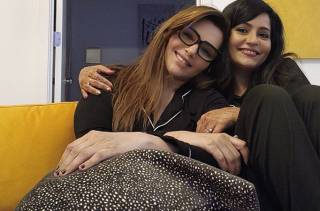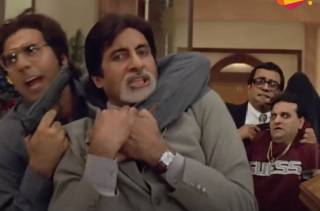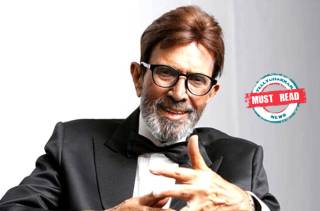As Bollywood’s first and by far the biggest superstar lost the battle between life and death, the wonder is that Rajesh Khanna begins to seem even more unreal and phenomenal than ever before.
Submitted by
SubhashKJha
on
Thu, 07/19/2012 - 18:21

As Bollywood’s first and by far the biggest superstar lost the battle between life and death, the wonder is that Rajesh Khanna begins to seem even more unreal and phenomenal than ever before.
Khanna’s golden period lasted exactly three years. Between 1969 and 1971 when Rajesh Khanna was the undisputed king of the world. And he never let anyone forget it. As hit after hit flowed out of his repertoire Khanna climbed to a position where all his contemporaries began to feel seriously left out in the rat race. Jeetendra, who was a close friend of Khanna, openly though good-naturedly grumbled about Khanna cornering all the plum projects that were available for the Bollywood leading man in the closing year of the 1960s and the opening years of the 1970s.
When Rajesh Khanna ruled, the competition simply vanished.
Khanna’s track record during that period was beyond phenomenal. It was staggering! Beginning with Shakti Samanta’s Aradhana which came and blew open the box-office in 1969, the hits simply flew out like there was no tomorrow: Aradhana was quickly followed by Narendra Bedi’s Bandhan, B R Chopra’s Ittefaq, Raj Khosla’s Do Raaste, Shakti Samanta’s Kati Patang, Manmohan Desai’s Sachcha Jhutha, Dulal Guha’s Dushman and J Om Prakash’s Aan Milo Sajna, all within a span of three years.
No star in the history of Indian cinema had so many hits flowing out so fast and furiously. With Chinappa Devar’s Haathi Mere Saathi (arguably the biggest hit of his career) Khanna’s career peaked. The Khanna frenzy touched the sky. Kids loved their haathi uncle as much their grandmothers adored Anand Babu who hated tears.
Then, it all ended. Suddenly the downslide started. In 1972, six of Khanna’s prestigious projects bombed one after another. Epitaphs for his career were written, and not unhappily. Though Khanna bounced back with some notable hits in 1974 (Aap Ki Kasam, Premnagar and Roti) the best was behind the nation’s beloved Kakaji.
Stories of Khanna’s arrogance and high-handedness had begun to gain credence. Manmohan Desai, a close friend of Khanna, after two blockbusters Sachcha Jhutha and Roti switched to Amitabh Bachchan with Amar Akbar Anthony, and there was no looking back for Khanna.
There were stories of how the superstar insisted on setting up projects entirely on his own terms. The music had to be by R.D. Burman and none other, although the combo had run out of steam. By the time Khanna and RD worked together in Alag Alag in 1985 which was directed by the Khanna’s loyalist Shakti Samanta for Khanna to romance his real-life love-interest Tina Munim, the creative juices had run dry. The film came after nearly a year of ‘together’ interviews where the fast-fading star and the pretty starlet spoke about everything they shared, including a lungi and, eeew, toothbrush.
Alag Alag flopped, and so did all the other films that Khanna did with Ms Munim excluding Sawan Kumar’s Soutan, the surprise success of 1983, the year when Khanna has a cloudburst of temporary success with Agar Tum Na Hote, Soutan and most notably Avtaar.
The trouble with Rajesh Khanna’s career was excessive subjectivity. He not only mixed business with pleasure, he even made sure that the business of pleasure was brought home to his famous bungalow Ashirwad where every evening, the Khanna durbar of sycophants and loyalists gathered for drinks and gupshup.
Anju Mahendroo, Khanna’s steady girlfriend of seven years and a practical woman, hated the yes-men who crowded Rajesh Khanna’s life and allowed him no room to grow. She wanted all the fakes and flatterers to go.When they wouldn’t be shown the door, Anju quit the relationship.
Says one of Rajesh Khanna’s heroines, “When Anju left Kaka he hurled downhill at a rapid pace paving the way for Amitabh Bachchan to become the next superstar. If Kaka had not allowed the super-success of a spate of films in 1969-72 to blind his better judgment he would have continued as the reigning superstar for at least another decade and the Bachchan factor may not have happened when it did.”
Most of Rajesh Khanna’s well-wishers felt his overnight marriage to Dimple Kapadia in 1973 was a disastrous mistake for both of them.
Says a friend of the actor, “Dimple was half the Kaka’s age. She was completely besotted by him. Kaka was flattered to be getting so much attention from Raj Kapoor’s heroine. He always had a fascination for all the things that Raj Saab discovered. When on the spur of the moment he proposed to Dimple she quickly accepted. Kaka made her throw the ring that was gifted to her by Rishi Kapoor into the sea to prove her loyalty to him. Drama was always a constant in the superstar’s life.”
The stormy marriage to Dimple lasted for 5-6 years. When she walked out with their two daughters to pursue a career, Rajesh Khanna was left in their bungalow Aashirwad with a huge persecution complex and little else to keep him company.
Says a male co-star, “Kaka loved to play the martyr both in his real life and reel. He would justify his transgressions as husband and family man by arguing that he was misunderstand. On screen he repeatedly revealed a death-wish. It’s no coincidence that his character died in film after film: Aradhana, Safar, Anand, Andaz, Namak Haraam. He saw himself as a combination of Guru Dutt and Devdas and his roles repeatedly reflected this obsession.”
The story goes that during Namak Haraam Hrishikesh Mukherjee was not sure which of the two heroes would finally die. It could have been either Khanna or the Big B. But Khanna insisted on getting the privilege. On the day that the director was supposed to shoot the death scene he placed a garlanded picture of Khanna on the wall.
Getting his way became a matter of habit for Khanna. In his head he remained a superstar, albeit in exile, even when the number of guests at Ashirwad dwindled to nothing. In their defense it must be said Khanna’s friends were not treated well.
Shakti Samanta who cast Khanna in almost all his films between 1969 and 1985 was persuaded to cast Rajesh Khanna’s sister-in-law Simple Kapadia opposite Khanna in the otherwise-watchable Anurodh. The film bombed.
Aradhana not only gave the industry one of its most beloved star pairs (Rajesh-Sharmila) it also started a durable friendship between Khanna and the film’s director. Shakti Samanta, music composer R D Burman and Rajesh Khanna became an inseparable trio of friends.
But the ‘camp’ culture which the slipping superstars patented also isolated him from a major chunk of talent in the industry. Yash Chopra was a very close friend of Khanna from the time the two worked together in Ittefaq in 1969. Naturally when Yash Chopra broke away from his brother B R Chopra to direct and produce Daag in 1973 he cast Khanna in what turned out to be one of the star’s bigger and final hits.
But after that the cracks began to show in the Yash Chopra-Rajesh Khanna friendship. Not too many people know Khanna was to play the lead in Deewaar. He demanded some changes in Salim-Javed’s script .He was replaced by Big B.
Career blunders multiplied. In 1979 Khanna launched his ambitious epic production Majnoon to be directed by the Pakeezah director Kamal Amrohi. The project never went beyond the grand mahurat. A few year later the fading superstar ate back his own words about never working with his wife and invited Dimple to co-star with him in Jai Shiv Shankar (the title tried desperately to evoke the magic of a song that Khanna lip-synched to glory). That project too was aborted. By this time the Khanna phenomenon survived solely on nostalgia.
By the time the 1970s ended the show was over for Rajesh Khanna. But while the superstardom lasted it remained unique in its impact. Churning out a plethora of hits he never shied away from experimenting with characters. Early in his superstardom Khanna played a killer on the run in Ittefaq. In Amar Prem he happily took a backseat to Sharmila Tagore and child artiste Master Bobby. In Anand , considered his best performance , Khanna had no leading lady. In Basu Bhattacharya’s Aavishkar the superstar enacted eerily real scenes from a troubled marriage. In Red Rose he played a psychotic killer. In Bawarchi he donned a baggy half-trousers to play cook to a dysfunctional perpetually-grumbling family.
Interestingly, Jaya Bhaduri who played the lead in Bawarchi was not cast opposite Rajesh Khanna. The two never worked together. And after a guest appearance in Andaz neither was Khanna cast with the other reigning queen of the 1970s Hema Malini until Premnagar when Khanna’s career was waning and it was no longer enough to sell a film on his name.
What finally and actually finished off Rajesh Khanna’s superstardom were the games he played. He happily apportioned plum roles between his two favourite heroines Sharmila Tagore and Mumtaz and then in an interview he spoke slyly about how one of them would sulk when he spent time with the other.
Understandably the two ladies didn’t take too kindly to this sort of true confession. They kept a distance from him thereafter.
So did most of those who loved Rajesh Khanna, including his family and fans who returned just in time for the final chapter in the phenomenon’s life story.
Like

0
Love

0
Haha

0
Yay

0
Wow

0
Sad

0
Angry

0










Add new comment